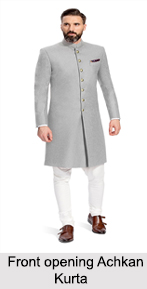 Greeks mention achkan and gown like dresses worn by men and women all the way during Mauryan period. It can be distinguished from the Sherwani through various aspects, particularly the front opening. Achkan traditionally has side-opening tied with strings. This style of opening is known as baghal bandi but frontal opening were not uncommon, similar to Angarkha. Sherwani always has straight frontal opening due to its function as outer-coat. Achkan, like Angarkha was traditionally worn with sash known as patka, kamarband or dora wrapped around the waist to keep the entire costume in place.
Greeks mention achkan and gown like dresses worn by men and women all the way during Mauryan period. It can be distinguished from the Sherwani through various aspects, particularly the front opening. Achkan traditionally has side-opening tied with strings. This style of opening is known as baghal bandi but frontal opening were not uncommon, similar to Angarkha. Sherwani always has straight frontal opening due to its function as outer-coat. Achkan, like Angarkha was traditionally worn with sash known as patka, kamarband or dora wrapped around the waist to keep the entire costume in place.
Formation of Achkan
The Achkan is a full-sleeved tunic with a high round neck. This garment has a length, which falls about 3-5 cm. above the knee. It has a full front opening in the centre and is fastened with buttons and buttonholes. Achkan is worn among all communities in combination with a churidar, especially on formal occasions. The initial panels-the bodice and skirt are cut from a single length and are flared at the side-seams. The armholes of the achkan are a little curved, in contrast to the straight armholes of garments like the angarkha and jama. The sleeves are tapered with a fitted effect, ending at the wrist. The neck is finished with a small stand-up collar, known as the Nehru or Chinese collar. Slits are made near the side of the hem and on the cuff of the sleeve. It is lined on the inside, giving it a clean finish.
Another garment of similar pattern like Achkan is the shervani. This is worn in certain parts of Rajasthan and that, too, mostly at weddings. The shervani differs from the achkan in its length and flare. It is longer and falls 3-5 cm below the knee and has a wider flare.
Unlike the earlier outer-garments worn by men, these fitted long coats with closed-neck acquired a more tailored-look. Instead of attaching the square cut sleeves at right angles to the main body of the fabric, as in the puthia, the arm-holes were curved and the sleeves structured to fit. The achkan became a fashion statement in most courts at the turn of the last century. It was tighter fitting around the wrists, chest and waist, tapering out at the hips to flare around the knees. As a result, the achkan was more streamlined than its predecessors. Purely for purposes of ornamentation, embroidered borders were often added around the collar, front edges and hems. It is still the most popular item of formal clothing in India today and commonly worn at weddings.
Evolution of Achkan
The achkan kurta may have its forefathers in the ancient Mauryan, Parthian or Central Asian Empires, but today, it has been widely embraced by men both in India and Pakistan. A few years ago, it was first adopted by the royalties of the Sikh, the Maratha and the Rajput communities. Throughout the 19th century the achkan and shervani gradually replaced the angarkha, jama and choga as the main outer-garment worn by men in the royal courts. The evolution of these close-fitting jackets and coats came through the gradual incorporation of British clothing styles into Indian attire. Native textiles and their integral decorative elements were still favoured over imported fabrics and certain stylistic elements of the angarkha, jama and choga were also retained.
Styles of Achkan
As achkan kurtas come in deep solid and rich fabrics, it turns out to be the best attire for showcasing family heirlooms like a vintage pearl or stone necklace, finger-ring or brooch. Not long ago, the achkan kurta was strictly an attire for men of royalty and nobility.
Some achkan kurtas come slightly embellished but that does not meddle with the attire"s classy appeal. Indian embroidery like gota and badla, Swarovski crystal work, royal zari thread work, semi-precious stone work etc. go well with achkans.
Achkans originally had a side-opening with string mechanism. This style was called the baghal bandi. But achkans with frontal opening are not uncommon today. It was traditionally worn with a sash. The patka or dora or kamarband was wrapped around the waist to give shape and form to the entire outfit. The achkan kurta is worn with either a dhotior churidar, tapered trousers or cigarette pants.
The achkan kurta has counterparts all over the Indian subcontinent. It is known as daurain in Nepal and Northeast India, angi in South India and chola or cholu in the Indian Himalayas.





















